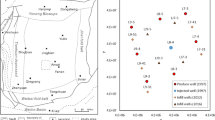Due to the differences in sedimentary parameters, as well as in the oil development and production conditions, the physical parameters of polymer flooding blocks are different, which affects the enhanced oil recovery effect of polymer flooding of the target reservoir. It has been noted that there is a significant difference in the extent of enhanced oil recovery between different polymer flooding well groups, which complicates production control and recovery effect evaluation of polymer flooding. To evaluate the adjustment standards for polymer flooding stages, it is necessary to formulate the recovery effect standard curves for different types of polymer flooding well groups. In this paper, the dynamic and static data of the polymer flooding block have been analyzed to determine the sensitivity of each factor affecting the well group classification. The well group classification method is established using the grey correlation method and mathematical statistical analysis method. Then, the EnKF method is used to invert the fitted parameter equations for different well groups. Through the combination of the EnKF method and the numerical simulation method, the physical parameters of polymer flooding and the relative permeability curves are used to predict the development effect of different types of well groups, and the development effect standards of different types of polymer flooding well groups are established.











Similar content being viewed by others
References
Y. Xiao, B. Hou, X. Liu, and B. Cao, “Research on main control factors influencing fracturing effect of Jiaoshiba area based on grey relational analysis,” ARMA-CUPB Geothermal International Conference, Beijing, China (2019).
G. Qu, L. Liu, Y. Meng, and X. Li, “Geochronology and geochemical characteristics of lower Jurassic silicate in Wandashan terrane,” Basic Clin. Pharm.Toxicol.,125, 246-247 (2019).
J. Yang, B. Jin, L. Jiang, and F. Liu, “An improved numerical simulator for surfactant/polymer flooding,” SPE/ATMI Asia Pacific Oil & Gas Conference and Exhibition, Bali, Indonesia (2015).
Y. Wang, G. Li, A. C. Reynolds, “Estimation of depths of fluid contacts and relative permeability curves by history matching using iterative Ensemble-Kalman smoothers,” SPE J., 15(02), 1-17 (2010).
G. Qu, Y. Meng, A. Shen, Y. Guo, Y. Liu, Y. Tao, “Experimental study of the feasibility of air flooding in an ultra-low permeability reservoir,” Energies, 9(10), 1-10 (2016).
G . N æ v d a l , L . M . J o h n s e n , S . I . A a n o n s e n , a n d E . H . Ve f r i n g , “ R e s e r v o i r m o n i t o r i n g a n d c o n t i n u o u s m o d e l u p d a t i n g u s i n g e n s e m b l e K a l m a n f i l t e r , SPE J., 10(1), 66-74 (2003).
E. Arroyo, D. Devegowda, A. Datta-Gupta, and J. Choe, “Streamline assisted ensemble Kalman filter for rapid and continuous reservoir model updating,” SPE Res. Eval. Eng., 11(06), 1046-1060 (2006).
S. Aramideh, R. Borgohain, P. K. Naik, C. T. Johnston, P. P. Vlachos, and A. M. Ardekani, “Multi-objective history matching of surfactant-polymer flooding,” Fuel, 228, 418-428 (2018).
Acknowledgment
The study is supported by the Reform and Development Fund of Local Universities supported by the Heilongjiang Provincial Undergraduate Universities project (2020YQ17); Research on Water Invasion Mechanism and Percolation Law of Deep Water Gas Reservoir project (2019YDL-08); Research on Optimization Method of Oilfield Injection Production Strategy Based on Intelligent Optimization Algorithm project (2020YDL-25), NSFC grant (51804076), and NSFC of Heilongjiang Province grant (QC2018047).
Author information
Authors and Affiliations
Corresponding author
Additional information
Translated from Khimiya i Tekhnologiya Topliv i Masel, No. 4, pp. 94–98, July–August, 2021.
Rights and permissions
About this article
Cite this article
Jiang, N., Qu, G., Bo, L. et al. Research on Development Effect Standards of Polymer Flooding Well Group Based on ENKF Method. Chem Technol Fuels Oils 57, 676–689 (2021). https://doi.org/10.1007/s10553-021-01293-0
Published:
Issue Date:
DOI: https://doi.org/10.1007/s10553-021-01293-0



